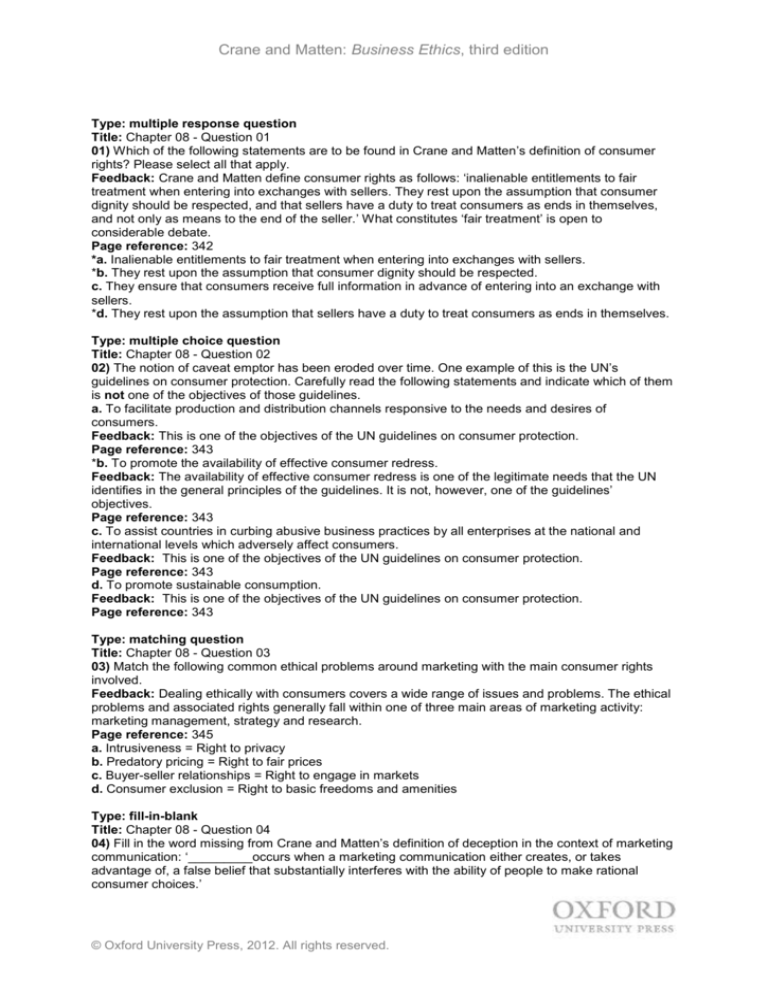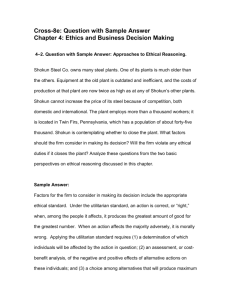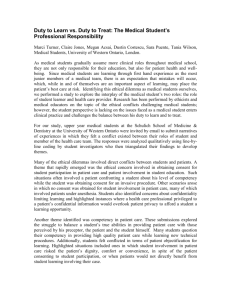
Crane and Matten: Business Ethics, third edition
Type: multiple response question
Title: Chapter 08 - Question 01
01) Which of the following statements are to be found in Crane and Matten’s definition of consumer
rights? Please select all that apply.
Feedback: Crane and Matten define consumer rights as follows: ‘inalienable entitlements to fair
treatment when entering into exchanges with sellers. They rest upon the assumption that consumer
dignity should be respected, and that sellers have a duty to treat consumers as ends in themselves,
and not only as means to the end of the seller.’ What constitutes ‘fair treatment’ is open to
considerable debate.
Page reference: 342
*a. Inalienable entitlements to fair treatment when entering into exchanges with sellers.
*b. They rest upon the assumption that consumer dignity should be respected.
c. They ensure that consumers receive full information in advance of entering into an exchange with
sellers.
*d. They rest upon the assumption that sellers have a duty to treat consumers as ends in themselves.
Type: multiple choice question
Title: Chapter 08 - Question 02
02) The notion of caveat emptor has been eroded over time. One example of this is the UN’s
guidelines on consumer protection. Carefully read the following statements and indicate which of them
is not one of the objectives of those guidelines.
a. To facilitate production and distribution channels responsive to the needs and desires of
consumers.
Feedback: This is one of the objectives of the UN guidelines on consumer protection.
Page reference: 343
*b. To promote the availability of effective consumer redress.
Feedback: The availability of effective consumer redress is one of the legitimate needs that the UN
identifies in the general principles of the guidelines. It is not, however, one of the guidelines’
objectives.
Page reference: 343
c. To assist countries in curbing abusive business practices by all enterprises at the national and
international levels which adversely affect consumers.
Feedback: This is one of the objectives of the UN guidelines on consumer protection.
Page reference: 343
d. To promote sustainable consumption.
Feedback: This is one of the objectives of the UN guidelines on consumer protection.
Page reference: 343
Type: matching question
Title: Chapter 08 - Question 03
03) Match the following common ethical problems around marketing with the main consumer rights
involved.
Feedback: Dealing ethically with consumers covers a wide range of issues and problems. The ethical
problems and associated rights generally fall within one of three main areas of marketing activity:
marketing management, strategy and research.
Page reference: 345
a. Intrusiveness = Right to privacy
b. Predatory pricing = Right to fair prices
c. Buyer-seller relationships = Right to engage in markets
d. Consumer exclusion = Right to basic freedoms and amenities
Type: fill-in-blank
Title: Chapter 08 - Question 04
04) Fill in the word missing from Crane and Matten’s definition of deception in the context of marketing
communication: ‘_________occurs when a marketing communication either creates, or takes
advantage of, a false belief that substantially interferes with the ability of people to make rational
consumer choices.’
© Oxford University Press, 2012. All rights reserved.
Crane and Matten: Business Ethics, third edition
Feedback: ‘Deception occurs when a marketing communication either creates, or takes advantage of,
a false belief that substantially interferes with the ability of people to make rational consumer choices.’
Some exaggeration or fantasy as part of a marketing campaign is unobjectionable. For example, it is
obvious that a well-known energy drink does not really give the drinker wings for a limited period of
time. The key is that such a claim is so obviously a fantasy that it does not substantially interfere with
the consumer’s ability to make a rational choice.
Page reference: 351
a. Deception
Type: multiple choice question
Title: Chapter 08 - Question 05
05) What responsibility are sellers often said to have, in relation to customers perceived to be
vulnerable in some way?
a. An obligation to charge a fair price.
Feedback: This is a key issue in the area of pricing, but it is not a specific responsibility vis-à-vis
vulnerable consumers. A consumer may be vulnerable for several reasons, such as serious illness,
young age, poverty, or senility. Where a seller is able to exploit the vulnerability of a potential
customer, it can be argued that the seller has an inherent duty to act in such a way as to respect the
interests of the consumer, as well as the interests of themselves and their company. This is known as
a duty of care.
Page reference: 360-361
b. A duty to promote sustainable consumption.
Feedback: This is part of the UN’s guidelines on consumer protection (see p343), but it is not a
specific responsibility vis-à-vis vulnerable consumers. A consumer may be vulnerable for several
reasons, such as serious illness, young age, poverty, or senility. Where a seller is able to exploit the
vulnerability of a potential customer, it can be argued that the seller has an inherent duty to act in such
a way as to respect the interests of the consumer, as well as the interests of themselves and their
company. This is known as a duty of care.
Page reference: 360-361
*c. A duty of care
Feedback: A consumer may be vulnerable for several reasons, such as serious illness, young age,
poverty, or senility. Where a seller is able to exploit the vulnerability of a potential customer, it can be
argued that the seller has an inherent duty to act in such a way as to respect the interests of the
consumer, as well as the interests of themselves and their company. This is known as a duty of care.
Page reference: 360-361
d. A duty to treat customers fairly.
Feedback: Consumers have a general right to be treated fairly, but this is not a specific responsibility
vis-à-vis vulnerable consumers. A consumer may be vulnerable for several reasons, such as serious
illness, young age, poverty, or senility. Where a seller is able to exploit the vulnerability of a potential
customer, it can be argued that the seller has an inherent duty to act in such a way as to respect the
interests of the consumer, as well as the interests of themselves and their company. This is known as
a duty of care.
Page reference: 360-361
Type: multiple response question
Title: Chapter 08 - Question 06
06) What do Crane and Matten identify as a focus for debate in the case of companies expanding into
new, international markets? Please select all that apply.
Feedback: For companies expanding into new, international markets, one of the main ethical issues
arising from globalization comes under the heading of ‘the export of consumerism and rise of cultural
homogenization’. The statements in the question all relate to this issue. The other broad issues that
Crane and Matten identify are ‘different standards of consumer protection’, and ‘the role of markets in
addressing poverty and development’.
Page reference: 365-366
*a. Erosion of local cultures and rise of cultural homogenization
b. The rise of neo-colonialism
*c. Increasing predominance of consumerist ideologies
*d. Deliberate removal of domestic rivals
© Oxford University Press, 2012. All rights reserved.
Crane and Matten: Business Ethics, third edition
Type: multiple choice question
Title: Chapter 08 - Question 07
07) What is the ‘bottom of the pyramid’ concept?
a. Focus on alleviating poverty by raising the real incomes of the poor.
Feedback: The bottom of the pyramid concept urges multinationals to tap into the ‘fortune at the
bottom of the pyramid’ of economic development by offering innovative goods and services to the
world’s poorest people. The idea is for multinationals to help bring about a ‘more stable, less
dangerous world’ through commerce rather than by spearheading global social development for
charitable purposes. It harnesses the argument of self-interest (Prahalad and Hammond, 2002).
Page reference: 367
b. Focus on social enterprise or cooperatives to maximize the ability of the poorest to lift themselves
out of poverty.
Feedback: The bottom of the pyramid concept urges multinationals to tap into the ‘fortune at the
bottom of the pyramid’ of economic development by offering innovative goods and services to the
world’s poorest people. The idea is for multinationals to help bring about a ‘more stable, less
dangerous world’ through commerce rather than by spearheading global social development for
charitable purposes. It harnesses the argument of self-interest (Prahalad and Hammond, 2002).
Page reference: 367
c. Focus on providing small loans to the poorest members of developing societies, who have no
access to formal credit facilities.
Feedback: The bottom of the pyramid concept urges multinationals to tap into the ‘fortune at the
bottom of the pyramid’ of economic development by offering innovative goods and services to the
world’s poorest people. The idea is for multinationals to help bring about a ‘more stable, less
dangerous world’ through commerce rather than by spearheading global social development for
charitable purposes. It harnesses the argument of self-interest (Prahalad and Hammond, 2002).
Page reference: 367
*d. Focus on offering innovative products and services to the world’s poorest people.
Feedback: The bottom of the pyramid concept urges multinationals to tap into the ‘fortune at the
bottom of the pyramid’ of economic development by offering innovative goods and services to the
world’s poorest people. The idea is for multinationals to help bring about a ‘more stable, less
dangerous world’ through commerce rather than by spearheading global social development for
charitable purposes. It harnesses the argument of self-interest (Prahalad and Hammond, 2002).
Page reference: 367
Type: multiple response question
Title: Chapter 08 - Question 08
08) What are the dimensions of Smith’s (1995) consumer sovereignty test? Please select all that
apply.
Feedback: The three dimensions are consumer capability (freedom from limitations in rational
decision-making), information (availability and quality of relevant data) and choice (opportunity for
switching to another supplier).
Page reference: 368-369
a. Consistency
*b. Consumer capability
*c. Choice
*d. Information
Type: multiple response question
Title: Chapter 08 - Question 09
09) Which of the following statements about ethical consumption would Crane and Matten agree with?
Please select all that apply.
Feedback: A small but significant proportion of purchases globally are influenced by ethical
considerations. Ethical consumers have therefore had a role in prompting firms to address ethics more
enthusiastically. Companies can adopt either a mainstream or ethical niche orientation to the ethical
marker. All of this means that consumers do act as a social control to business to some extent, though
ethical consumption will never be an adequate replacement for political action.
Page reference: 369-374
a. Given increasing political apathy and the rise of consumer activism, ethical consumption is likely to
become an adequate replacement for political action on a range of issues.
© Oxford University Press, 2012. All rights reserved.
Crane and Matten: Business Ethics, third edition
b. There is little doubt that a large and significant minority of purchases are influenced by ethical
considerations, and that this occurs across the globe.
*c. In responding to ethical consumers, companies have two basic options: they can either adopt an
ethical niche orientation, or they can take a mainstream orientation to the ethical market.
*d. Consumers can, to some extent, act as a social control on business.
Type: multiple response question
Title: Chapter 08 - Question 10
10) Buchholz (1998) identifies the changing ethics governing our societies as a factor in the move
towards more sustainable consumption. Which of the following statements is accurate according to
her model? Please select all that apply.
Feedback: Buchholz posits a move towards sustainable consumption. She argues that changes to
societal ethics happen slowly. Her argument is that the Protestant ethic was dominant during the
establishment of market systems in much of Europe. This gave way over time to the consumerism
ethic, which is currently dominant. She argues that we now need to move to an environmental ethic. A
socialist ethic does not appear in her model.
Page reference: 375-376, see esp. Figure 8.6
a. The Protestant ethic promotes alternative meanings of growth and investment in the environment.
*b. The consumerism ethic promotes instant gratification and consumption.
c. The environmental ethic promotes investment in productive capacity.
d. The socialist ethic promotes the generation of collective welfare.
© Oxford University Press, 2012. All rights reserved.





